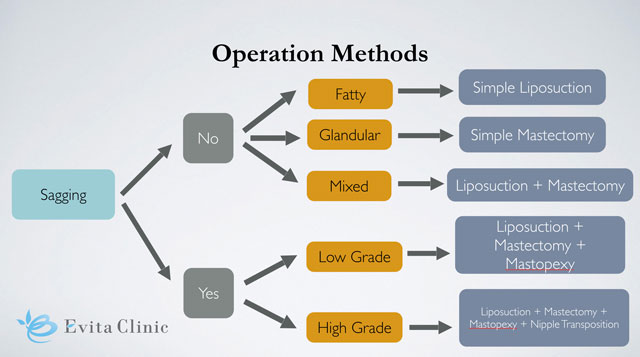Understanding Gynecomastia Classification
Gynecomastia can be classified in several ways to better understand the condition and determine the appropriate treatment. The classification can be based on the type of tissue overgrowth or the timing and cause of the condition.
1. Classification by Tissue Type
- True Gynecomastia: Characterized by glandular enlargement.
- False Gynecomastia (Pseudogynecomastia): Results from excess fat accumulation.
- Mixed Type: A combination of both glandular and fatty tissue overgrowth.
2. Classification by Onset and Cause
- Newborn Gynecomastia: A physiological response to high maternal and placental estrogen levels. Newborns may sometimes produce a secretion known as “witch’s milk.”
- Pubertal Gynecomastia: Occurs during puberty due to hormonal changes. Testosterone increases alongside growth hormone (GH), insulin-like growth factor-1, follicle-stimulating hormone (FSH), and luteinizing hormone (LH). Estrogen levels triple but peak earlier than testosterone.
- Adult Gynecomastia (Physiological): Develops as a natural part of aging. Free testosterone decreases while adipose tissue increases, leading to more estrogen production through the conversion of testosterone in fat cells.
- Adult Gynecomastia (Non-Physiological): Often linked to external factors such as medication, underlying health conditions, or hormonal imbalances.
Gynecomastia Grades According to ASPS
The American Society of Plastic Surgeons (ASPS) classifies gynecomastia into four grades based on the severity of breast enlargement and skin redundancy.
| Grade or Type | Description | Severity |
|---|---|---|
| 1 | A localized button of tissue that is concentrated around the areola | Very mild |
| 2 | Moderate breast enlargement exceeding areola boundaries with edges that are indistinct from the chest | Mild to high |
| 3 | Moderate breast enlargement exceeding areola boundaries with edges that are distinct from the chest with skin redundancy present | High and visible |
| 4 | Marked breast enlargement with skin redundancy and feminization of the breast | Severe and visibly feminine |

Choosing the Right Operation Method
At Evita Clinic, the choice of surgical method for gynecomastia depends on the severity of skin sagging. During a face-to-face consultation, Dr. Francis Jeon will assess your specific condition to determine the most appropriate treatment plan.

Operation Methods Based on Gynecomastia Grade
- Grade 1 & 2: Typically treated with liposuction or minimally invasive techniques.
- Grade 3: May require a combination of liposuction and glandular tissue excision. In some cases, circum-areolar skin resection may be considered to address predicted skin sagging.
- Grade 4: Often involves more extensive surgery to address skin redundancy and achieve a masculine chest contour. In cases of severe sagging, the nipple may need to be repositioned higher on the chest, which may require skin excision techniques such as the Anchor resection.
Personalized Approach to Gynecomastia Surgery
At Evita Clinic, the choice of surgical method for gynecomastia is tailored to each patient’s unique circumstances. Dr. Francis Jeon carefully evaluates multiple factors, including skin elasticity, degree of obesity, areola size, fat-to-gland ratio, and age.
For younger patients, minimizing scarring is a priority, while for those with significant skin sagging, advanced techniques such as circum-areolar resection or Anchor resection may be considered. Additionally, the amount of liposuction and the potential need for areola reduction are determined on a case-by-case basis.
Our ultimate goal is to achieve a natural, masculine chest contour with minimal visible scarring, ensuring the best possible aesthetic outcome. Every treatment plan is developed collaboratively with the patient to align with their expectations and needs.
For more information or to schedule a consultation, please contact us through our website or visit Evita Clinic.
